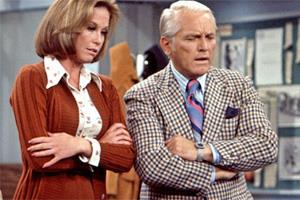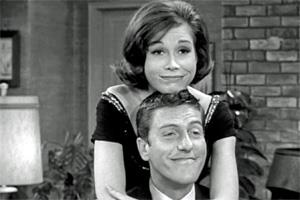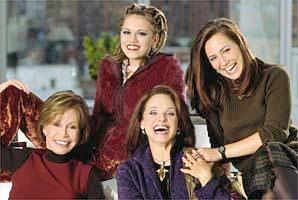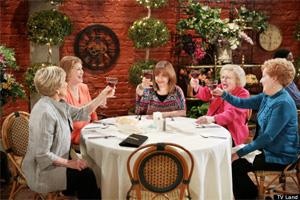Mary Tyler Moore never actually worked for a real-life local TV news team. It just seemed that way because of her indelible role as indomitable Mary Richards of Minneapolis’ WJM-TV.
The Mary Tyler Moore Show aired from 1970-’77 on CBS but was seen and savored by generations who either first discovered it in reruns or just kept enjoying it over and over again. It will ever be thus long after Moore’s death Wednesday at age 80.
Television’s reigning First Lady of comedy may be Julia Louis-Dreyfus. But Moore, Lucille Ball, and the still-surviving Carol Burnett have long occupied TV’s Mount Rushmore of this genre. All were influential, groundbreaking and will never be dislodged.

Moore, unlike Ball or Burnett, wasn’t classically funny and didn’t lean heavily, if it all, on sight gags to get big laughs. Instead, she was the glue as the sometimes- frazzled WJM producer who left the outsized cavorting to her ensemble cast members, most notably the late Ted Knight (left, with Moore) as buffoonish anchorman Ted Baxter. Mary Richards could always be relied on for support as a single woman who stayed that way throughout the show’s award-laden run. The character had broken off an engagement to a medical student before heading to the great unknown of Minneapolis, where she tossed her hat in the air and would “make it after all.”
Behind the scenes, Moore and her then-husband, Grant Tinker, created MTM Enterprises in 1969 and immediately tailored The Mary Tyler Moore Show to her talents. Tinker, who died in November, went on to become the ultra-classy chairman of the NBC television network.

Moore first came to fame as housewife Laura Petrie on CBS’ The Dick Van Dyke Show, which aired from 1961-’66. But The Mary Tyler Moore Show is considered her crowning achievement. She won multiple acting Emmys in both roles before collecting nominations for serious dramatic parts ranging from Betty Rollin in First, You Cry to Mary Todd Lincoln in Lincoln. Her only non-comedy win and last Emmy nomination for a sobering role was in 1993 for Stolen Babies. She also received a lone Best Actress Oscar nomination in 1981 for Ordinary People.
Moore battled diabetes throughout her adult life, and in later years was mostly content to reunite with her former comedy series colleagues. I had two up-close brushes with her during the semi-annual Television Critics Association “press tour,” most notably in January 2000. She was promoting what turned out to be ABC’s Mary and Rhoda, a poorly made TV movie that paired Moore with Valerie Harper (her best friend Rhoda Morgenstern on The Mary Tyler Moore Show) for the first time in 26 years.
Following a formal press conference, Moore looked for a resting spot from which to take a few more questions from reporters circling her outside a hotel ballroom. She settled for a small table otherwise occupied by miniature figures from the Easter claymation special The Miracle Maker. Moore accidentally knocked Jesus off his feet before hastily righting him as part of an unintended sight gag.
She had wanted Mary and Rhoda to be a weekly series, but script problems nixed that idea. Still, her “unshakable belief in the project” prompted her to push for a movie of the same name. Moore eventually won out, was proud of herself and said she planned to write a book about “the emergence of me as a mature woman who’s finally able to stand on my own two feet and say, ‘I have learned a lot about this business. I know a thing or two that a lot of other people don’t.’ I had been carrying feelings almost from day one that I’m a good actress but not good at very much else. And now I’ve proven differently.”
It was quite a statement from a woman whose portrayal of Mary Richards helped to usher in legions of self-standing single women in comedies ranging from Cheers to Seinfeld to 30 Rock. The headline of her obituary in The New York Times says that Moore “incarnated the modern woman on TV.”

She later tried and failed in several variety hours and drama series that were meant as very separate second acts to Mary Richards, but never jelled with viewers. All were for CBS, and Moore said she assumed that Mary and Rhoda (right) would be as well. But when she finally had steeled herself to revisit the role, CBS tried to talk her out of it.
“It didn’t scare me at all,” Moore recalled in that impromptu 2000 interview. “But I think it scared the hell out of (then CBS President, now chairman/CEO) Les Moonves, who was the first one I brought the idea to. And he said, ‘Do you realize you’re talking about possibly casting a shadow over what was arguably the best situation comedy ever on television?’ And I said, ‘Yes, but are you really going to walk away from this opportunity?’ “
Moore said that CBS unenthusiastically agreed to pay for a script, but ABC countered with a firmer commitment to Mary and Rhoda, which in retrospect turned out not to be a very good idea after all.
Three years later, Moore and Van Dyke got back together for the oft-profane PBS adaptation of The Gin Game. They hadn’t done anything on screen since 1968 when Moore joined Van Dyke for an hour of song and dance on Dick Van Dyke and the Other Woman.
“Well, we had to be old enough,” Moore joked during an interview session when asked why it had taken so long.
Van Dyke shaved his mustache for the Gin Game role, which made Moore “so glad. I mean, he has a face that should be seen, not covered up.”
She also admitted to having “the biggest crush” on Van Dyke ever since seeing him on Broadway in 1960’s Bye Bye Birdie.
“The amazing thing is, we never had an affair,” Moore said. “I always thought of it as a terrible waste.”
Neither of the old-line stars had any appetite for a wave of “reality” series that at the time included The Bachelorette and Joe Millionaire.
“Makes me embarrassed to be a member of the human race,” said Moore.

Van Dyke and Moore reunited again in 2004 for CBS’ one-hour The Dick Van Dyke Show Revisited, a collection of reminiscences and clips. Her last TV appearance came in 2013, also for nostalgia purposes. Moore guested on TV Land’s Hot In Cleveland (left) with all four of her former Mary Tyler Moore female co-stars -- Harper, Betty White, Cloris Leachman and Georgia Engel. This time, however, Moore played a former bowling buddy named Diane.
Moore ended up with an armload of Emmys, a TV Hall of Fame berth and a priceless legacy from a show that once formed the midsection of the greatest prime-time comedy lineup in TV history -- and on Saturdays no less. In the 1973-’74 TV season, from 8 to 11 p.m. ET, CBS offered All In the Family, M*A*S*H, The Mary Tyler Moore Show, The Bob Newhart Show and The Carol Burnett Show.
That kind of history will never ever repeat itself. Mary Tyler Moore likewise remains unique as a star among stars who joined Burnett in letting others shine and repeatedly steal scenes in a show named after her. The glory of their times and primes is still a lesson to all genders and genres.
Email comments or questions to: unclebarky@verizon.net